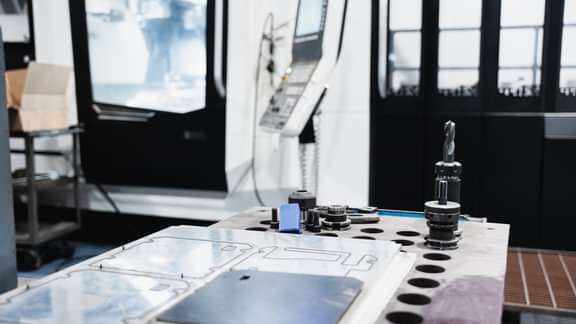
At Behlen Custom Fabrication, we leverage high-precision CNC machining technology to produce complex and accurate parts from various materials such as metal, plastic, wood, and composites.
CNC machining refers to a manufacturing process where computer numerical control (CNC) systems are used to automate the operation of machine tools. Our machine tool selection includes lathes, mills, vertical machine center (VMC), saws, a planer with capacity up to 60" x 60" x 18', surface grinders and ⅜" x 11" CNC shears.
Here's how CNC machining at Behlen Custom Fabrication works:

Design
The process begins with the creation of a digital design or computer-aided design (CAD) model of the part to be machined. This model defines the geometry, dimensions, and features of the final part.
Programming
Using computer-aided manufacturing (CAM) software, a CNC programmer generates a toolpath or sequence of machining operations based on the CAD model. This involves selecting appropriate cutting tools, machining parameters, and strategies to achieve the desired part specifications.
Setup
The machinist sets up the CNC machine by installing the required cutting tools, loading the workpiece onto the machine, and securing it in place using workholding devices.
Execution
The CNC program is loaded into the machine's control unit, and the machining operation is initiated. The CNC system precisely controls the movement of the cutting tools relative to the workpiece, removing material according to the programmed instructions.
Monitoring and Inspection
During machining, operators monitor the process to ensure proper tool performance, part quality, and dimensional accuracy. Inspection tools such as calipers, micrometers, and coordinate measuring machines (CMMs) may be used to verify part dimensions and tolerances.
Finishing and Post-Processing
After machining is complete, the parts may undergo additional finishing operations such as deburring, surface treatment, or assembly, depending on the specific requirements of the application.
CNC Machining Components and Features
- Computer Numerical Control (CNC): At the heart of CNC machining is the CNC system, which consists of a computer and software that control the movement and operation of the machine tool. The CNC system interprets digital instructions, typically generated from computer-aided design (CAD) models or computer-aided manufacturing (CAM) software, and translates them into precise movements of the machine's cutting tools.
- Machine Tool: CNC machining encompasses a wide range of machine tools, each designed for specific types of machining operations. Some common types of CNC machine tools include:
- CNC Milling Machines: Used for milling, drilling, and cutting operations. They feature rotating cutting tools that remove material from a workpiece to create complex shapes and features.
- CNC Lathes: Used for turning operations, where a rotating workpiece is machined using stationary cutting tools. Lathes are commonly used for cylindrical parts such as shafts, rods, and bushings.
- CNC Routers: Similar to milling machines but designed for cutting and shaping wood, plastic, and other softer materials. Routers are often used in woodworking, cabinetry, and sign-making industries.
- CNC Grinders: Used for precision grinding operations to achieve tight tolerances and surface finishes. They are commonly used in tool and die making, aerospace, and automotive industries.
- Tooling: CNC machining requires various cutting tools, such as end mills, drills, inserts, and lathe tools, depending on the specific machining operation and material being processed. Tooling selection is crucial for achieving desired part dimensions, surface finishes, and tolerances.
- Workholding: Workholding devices, such as vises, chucks, fixtures, and clamps, are used to secure the workpiece in place during machining operations. Proper workholding ensures stability and accuracy during cutting processes.
CAD/CAM Software: CAD software is used to create digital models of parts or components, while CAM software generates toolpaths and machining instructions based on the CAD models. These software tools play a vital role in programming CNC machines and optimizing machining processes for efficiency and accuracy.

